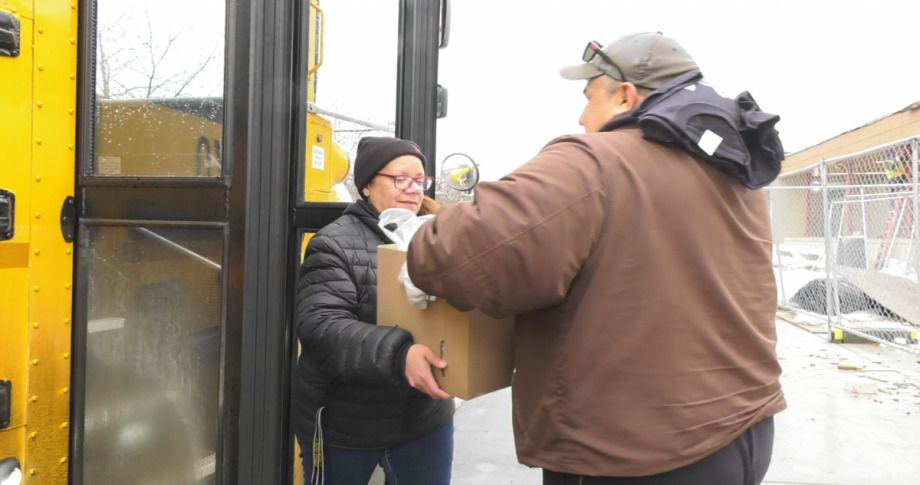As Minnesota ordered all public schools to close due to the COVID-19 pandemic, Saint Paul Public Schools mobilized.
Two-thirds of the school district’s 36,000 students qualify for free or reduced-price lunch. Losing that source of food would affect thousands of children and adolescents in Saint Paul, Minnesota. So the district had 60 hours to come up with a plan to keep feeding those students, even as schools shut their doors.
“None of us have faced anything like this before, managers down to frontline employees,” says Stacy Koppen, nutrition services director at Saint Paul Public Schools.
Starting March 18, Saint Paul Public Schools joined dozens of other districts around the country in turning their school buses into meal delivery vehicles.
School districts nationwide must keep feeding students who qualify for free or reduced-price lunches, even as COVID-19 has halted classes and large gatherings. To do this, districts in many states, from South Carolina to New Mexico to Vermont and beyond, are delivering meals by school bus — some for the first time.
In a survey conducted in mid-March, 1,211 school districts reported they were either engaged in or developing plans for emergency meal assistance and feeding students during school closures, according to the School Nutrition Association. That includes delivery by bus. (Of the more than 13,000 public school districts in the country, 1,769 responded to the survey.)
“Certainly in low-income communities, delivering via bus routes is a really easy way to get those meals out to families,” says Diane Pratt-Heavner, spokesperson for the School Nutrition Association.
Some students struggle to access food during the summer months. So for the past few years, many districts have operated limited bus delivery, serving meals to students at designated drop-off points.
But schools using traditional bus routes to supply meals is a new concept, Pratt-Heavner says.
Saint Paul Public Schools decided to deliver meals by bus because it reduces the number of people in a single place and helps those without transportation, Koppen says.
About 275 bus drivers, who are accompanied by teaching assistants on busier routes, make deliveries. Children receive 10 meals — five breakfasts and five lunches — during a weekly pickup.
Multiple school districts in Georgia also deliver meals by bus. DeKalb County School District in metro Atlanta started with 21 sites where people could come to pick up food. But parents began calling to say they didn’t have transportation to reach those sites.
“We were not reaching all the students within the district,” says Connie Walker, executive director of school nutrition at DeKalb County School District.
So a week after beginning curbside pickup, DeKalb added bus delivery on March 23. The district has just over 100,000 students, with 73 percent qualifying for free or reduced-price meals, and delivers to about 10,000 people per day. Meals get delivered three days a week and include a lunch and a snack for every day, including weekends.
In addition to the driver, each bus has a food service assistant to help dispense food. Like Saint Paul’s program, DeKalb gives food to anyone 18 and under.
Keeping students and staff safe as COVID-19 spreads is a concern. An employee contracting COVID-19 has not only the usual risks but could also stop services. A school district in Lexington, Kentucky, ended its bus deliveries after an employee tested positive for COVID-19.
DeKalb and Saint Paul call for handwashing and social distancing in the kitchens that make the meals. In addition, Saint Paul has begun staggering work shifts so kitchen workers interact with each other less.
“We really have to be able to protect this food system,” Koppen says. “If someone were to get the virus in our central kitchen, which is where we’re putting those meals together, it would shut down the entire operation.”
Schools also face tightening budgets. Meal programs are expected to be self-sustaining through federal reimbursements and cafeteria sales, which don’t happen when school is closed.
“These programs are in many cases paying staff, but their meals delivered or served have gone way down,” says Pratt-Heavner of the School Nutrition Association.
The federal reimbursement rate is about $3.50 per lunch. “That’s not a lot of money when you’re talking about a meal that includes milk and a fruit and a vegetable and protein and a grain,” Pratt-Heavner adds.
Bus deliveries present other financial constraints. They rely more on prepackaged items, which schools say cost more than a traditional meal. They also need sturdy boxes to transport the food.
Federal reimbursements don’t cover staff, meals and all of the necessary equipment. “I can guarantee you that the amount of money that we’re spending just on food is going to eat up most of that money,” Koppen says.
Still, bus delivery programs borne out of COVID-19 closures could inspire schools to offer it during summers.
DeKalb offers breakfast and lunch pickup at schools during the summer, which Walker says doesn’t reach all the students who need it. Buses could be an answer.
“In order for us to increase our participation, we would be willing to look at this, since we’ve gone through it right now,” she says. “It’s an opportunity for us to grow our program.”
Saint Paul bought a used food truck around 2015 to deliver summer meals to students without transportation. The size of an ice cream truck, it serves 300 meals daily.
“This is kind of my dream, but when we finally get to come back, I really want to expand our mobile program for the summer,” Koppen says. “If we could get another couple of food trucks, hopefully through a grant, I think this has really told us that that’s exactly what our community really needs.”
But that’s the future, and right now, schools work on continuing to feed students while classes are out for COVID-19. Saint Paul has relied on grants from the nonprofits No Kid Hungry and Second Harvest in addition to federal reimbursements.
The district has enough funds through May 1.
“We’re not really certain what’s going to happen after that,” Koppen says. “Our supply costs are just through the roof, along with those food costs. So we really need the federal government to step in and to recognize that and provide some additional funding in order for us to be able to continue to feed the people in our state.”

Adina Solomon is a freelance journalist based in Atlanta. She writes on a range of topics with specialties in city design, business and death. Her work has appeared in The Washington Post, CityLab, U.S. News & World Report, and other national and local outlets.
















